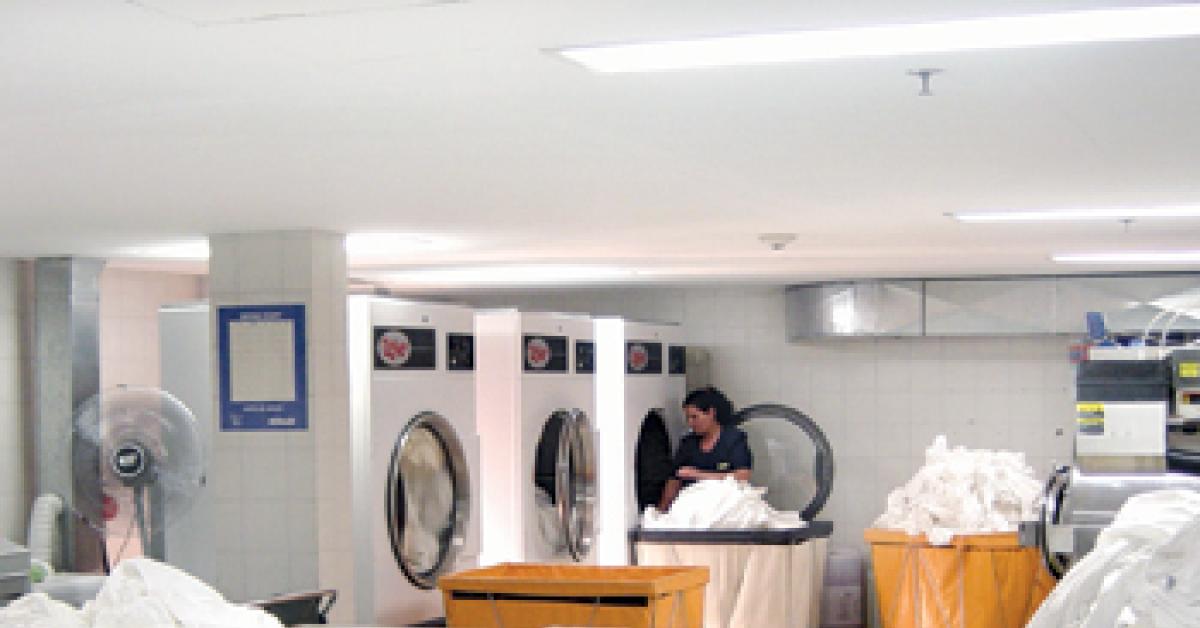RIPON, Wis. — Many businesses continue to feel the impact of the economic downturn. And while it may be hard to improve revenue streams, some businesses have found savings by reducing energy usage and increasing efficiency in their on-premise laundry.
Energy-efficient laundry equipment and advanced controls are playing key roles in the battle to reduce spending significantly by increasing operating efficiency and ensuring optimal performance.ENERGY-EFFICIENT EQUIPMENT
For those on-premise laundries that haven’t updated their equipment mix in some time, there could be many inefficiencies lurking around the laundry room. Washer extraction rates may be low, leaving more water in linens, causing longer dry times. Older dryers tend to have leaks in door gaskets, allowing heat to slip out through cracks. These inefficiencies contribute to higher energy usage and utilities cost.WASHER-EXTRACTORS
When determining if it’s time to make an investment in new equipment, managers should start with their washers. A machine spinning at 500-600 rpm is less efficient at extracting water during the spin cycle. A washer-extractor operating at 800 rpm reduces the amount of moisture left in the linens by 47%. It also decreases drying time by more than 40% and gas usage by at least 35%.DRYERS
Tumble dryers are one of the largest energy consumers in the laundry room, but their costs can be reduced using simple methods, including adjusting the temperature settings on advanced controls.
The greatest energy-consumption improvements, however, can be found in decreasing dry time. Look for a tumbler that has a design balance of heat, tumble action and airflow. Faster dry times and lower Btu consumption help reduce energy costs, and design features such as tighter tolerances force hot air through linens instead of around them.
Reversing cylinders can also be advantageous if you are processing large items like king sheets. The reversing action reduces tangling and shortens drying time.
Laundry experts believe 90% of OPL dryers are set far longer than necessary, overdrying by an average of six minutes per load. Modern dryers automatically shut off when the laundry is adequately dried. Eliminating six minutes from each of 10 loads can save an hour of labor a day and more than $660 in natural-gas expenses annually.ADVANCED CONTROLS
Today’s laundry controls function as an on-site manager, offering unparalleled control and connectivity. They provide easy access to laundry operations data, helping managers deal with water and energy usage, equipment issues, and maximizing employee performance.
With newer controls, managers can program water levels and detect leaks before such resources have been wasted. They also help increase operating efficiencies. Date and time stamps for a variety of machine activities give managers the data to identify when cycles start and end, including the amount of time between cycles. Too much time between cycles may indicate that staff time is not being allocated wisely.UTILITY MISER
Standard programs in on-premise laundries typically only have three water levels to select from—low, medium and high. However, state-of-the-art controls offer as many as 30 water levels.
A wider selection of water levels allows for small changes that can significantly impact annual water consumption by tens of thousands of gallons. Plus, if 60% of the water is heated, the energy savings can be even greater.
Advanced controls can also detect leaks, which can cause thousands of gallons of water to be wasted every year. The controls detect drain-valve obstructions (a frequent occurrence in on-premise laundries) and alert staff, helping reduce, if not eliminate, unnecessary water costs.
Beware—many companies brag that their machines save up to 50% in water usage. However, water consumption is mostly determined by washer programming, not washer hardware. Even with multiple water levels, it can be difficult to save more than 10% in water while maintaining superior wash quality.QUALITY-CONTROL PARTNER
Newer controls also help monitor whether standard operating procedures are being followed. With quality-control reports, managers can tell when employees have taken shortcuts, such as aborting cycles prematurely. In some locations, up to 10% of the cycles have been aborted. When operators decide to add more linen, it can cause excessive water and chemical use.
These types of reports also can be used as a training mechanism, helping to show managers where supervision needs to be focused or more training needs to be provided.
In addition, managers can monitor the machines’ maintenance. Newer controls have built-in maintenance messages that remind laundry managers what they should attend to on a daily, weekly, monthly and quarterly basis. Staying on top of maintenance allows managers to proactively address machine issues and helps reduce downtime for machine repairs.BOOSTING OPERATING EFFICIENCIES
Businesses such as hotels and long-term living facilities spend 45-55% of their laundry budget on labor expenses.
New control options such as delayed start can help save several hours of labor a week. This control feature allows machines to be loaded at the end of the day and programmed to start an hour before labor is scheduled the following day. And in facilities that require laundry employees to perform duties outside the laundry room, the control can be configured to send a signal to a remote location, such as the front desk. This allows the attendant to focus on the job at hand without wasting time.
Newer controls also help streamline training. Some manufacturers are offering the same control for the washer-extractor, as well as the tumblers, helping to decrease the time spent training employees on how to operate machines.INCREASED EFFICIENCY = INCREASED PROFITS
It’s easy to see why so many businesses are investing in sustainable technology. But don’t overlook back-of-the-house operations, because there are significant savings in those areas as well.
With advanced controls and efficient machines, on-premise laundries can save thousands of dollars annually in water, energy, labor and linen expenses. Now is the time to identify where savings will come from, and implement the right technologies to improve the business’ bottom line.
Have a question or comment? E-mail our editor Matt Poe at [email protected].
